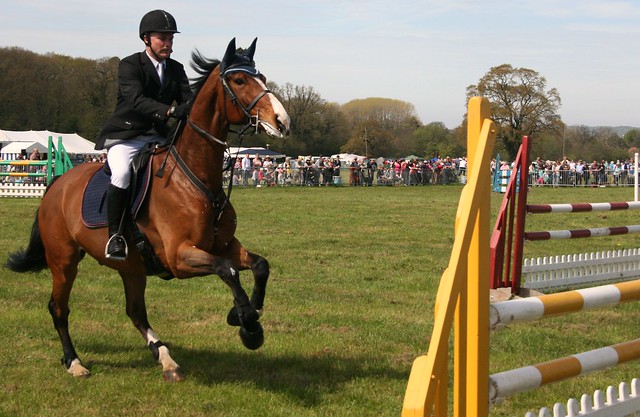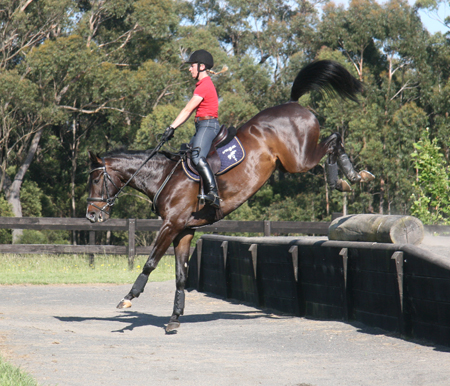I think it is important to know about the phases of a jump largely because of my dressage background. The more I know what is supposed to happen, the better I can use the tools that my trainers hand me. A quick example is something I tell me students often: the quality of the gait determines the quality of the transition, which then determines the quality of the gait.
Okay, great! Now what? What do I do with that?
Improve the gait BEFORE the transition, of course!
Uh.... how?
And this is our eternal question. This is one of my favorite topics because of my obsession with kinematic abnormalities but I'm going to try to stay on track a little longer here.
The approach:
The approach is often characterized by the horse either shortening or lengthening his strides in order to actually get himself over the jump - how much as a rider we encourage this is determined by which arena we're in. Show jumping? Hell yeah we encourage the horse to lengthen! As long as his feet can reach under his belly and subsequently under us, we'll encourage the horse forward! The hunters? Oh no no no keep your stride perfectly the same and measure it until that same stride length carries us to the perfect takeoff point? Stadium jumping? Our horses have to take care of us out on the cross country field and while I want to take over and pilot anytime I want, I also want my horse to know where his feet are well enough to assess the jump and get himself over it.
The take-off:
The horse's shoulders take off before the hindquarters gather to launch the horse forward, which is why is it SO IMPORTANT NOT TO JUMP AHEAD OF YOUR HORSE. If you jump ahead, you disturb the horse's balance and essentially trap the forelegs on the ground, rather than waiting for the powerful push from behind to fold you down over the horse.
You have to wait way longer than you think, you know.
The flight:
Using my dressage-reference earlier, the flight (also referred to as the phase of suspension), is the "transition." All the work up to this point determines the quality of this transition from the front of the fence to the back of the fence, and the quality of our flight is going to impact how we land.
For many riders, the flight is a moment of blackness, a breath of freedom, and a silent beat in the air. For those who work towards it or just have jumps about ten million jumps, they can feel the horse well enough to know how well the horse is using his back, which lead the horse will land on; they can use this moment to plan their arc and to see the next thing they'll need to do to prepare their horse. There's a whole psychological analysis involved in teaching a rider to think while jumping, so I should bookmark that as a topic for another day.
The descent:
Once again, the shoulders have a whole lotta stuff to do in the descent. They land and take off again before the hindquarters have come down, withstanding an incredible amount of force and yet retaining their agility. Horses are incredible, amazing athletes.
The getaway:
On a total side-note, it is remarkably difficult to find photos of the getaway because of how absurdly un-photogenic it is. The horse's weight is thrown forward, they're struggling to get their feet underneath them again, and their balance is wonky. This is why it's important to treat the getaway as an important rebalancing moment -- don't allow the horse to rush onward, hindquarters trailing out, else you risk pulling rails on your very next jump.
The getaway is actually the BIGGEST reason grids are such a powerful teaching force. Through no imput of the rider at all, the horse has to get his poop in a group and learn to very quickly rebalance and get his hindquarters under him. It's also why bounces are so very good for shoulder-strength; the horse has to provide an extra-powerful push in order to make room for the hindquarters to tuck under to take off again.
So that's my overview of the phases of a jump -- keep your eye out for a more detailed analysis of each phase at a later point!








this is super informative - and touch on topics i've been struggling with lately (ie, getting out of my horse's way over the fence) - thanks!! (also - all of my 'getaway' photos turn out pretty heinous. at least i sorta have an excuse now lol)
ReplyDeleteOh totally - I don't have a SINGLE good photo of me in a getaway. Keep your eyes out for the rest of the series! I've already started writing the more detailed posts & I'm looking forward to hearing what you think about them!
DeleteThank you for posting this! I am currently working on the approach, specifically getting his hind end underneath him and his shoulders lifted, so this was good to read.
ReplyDeleteYou're very welcome!
Delete